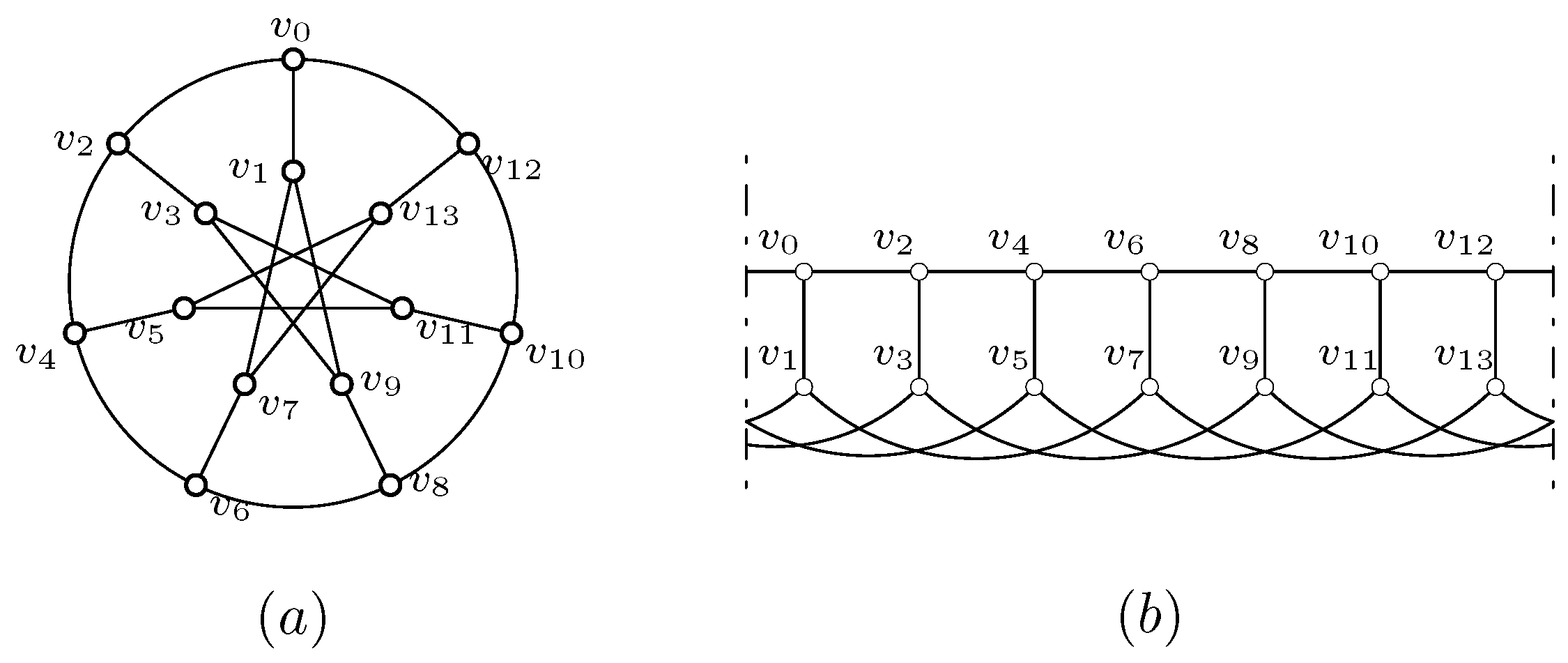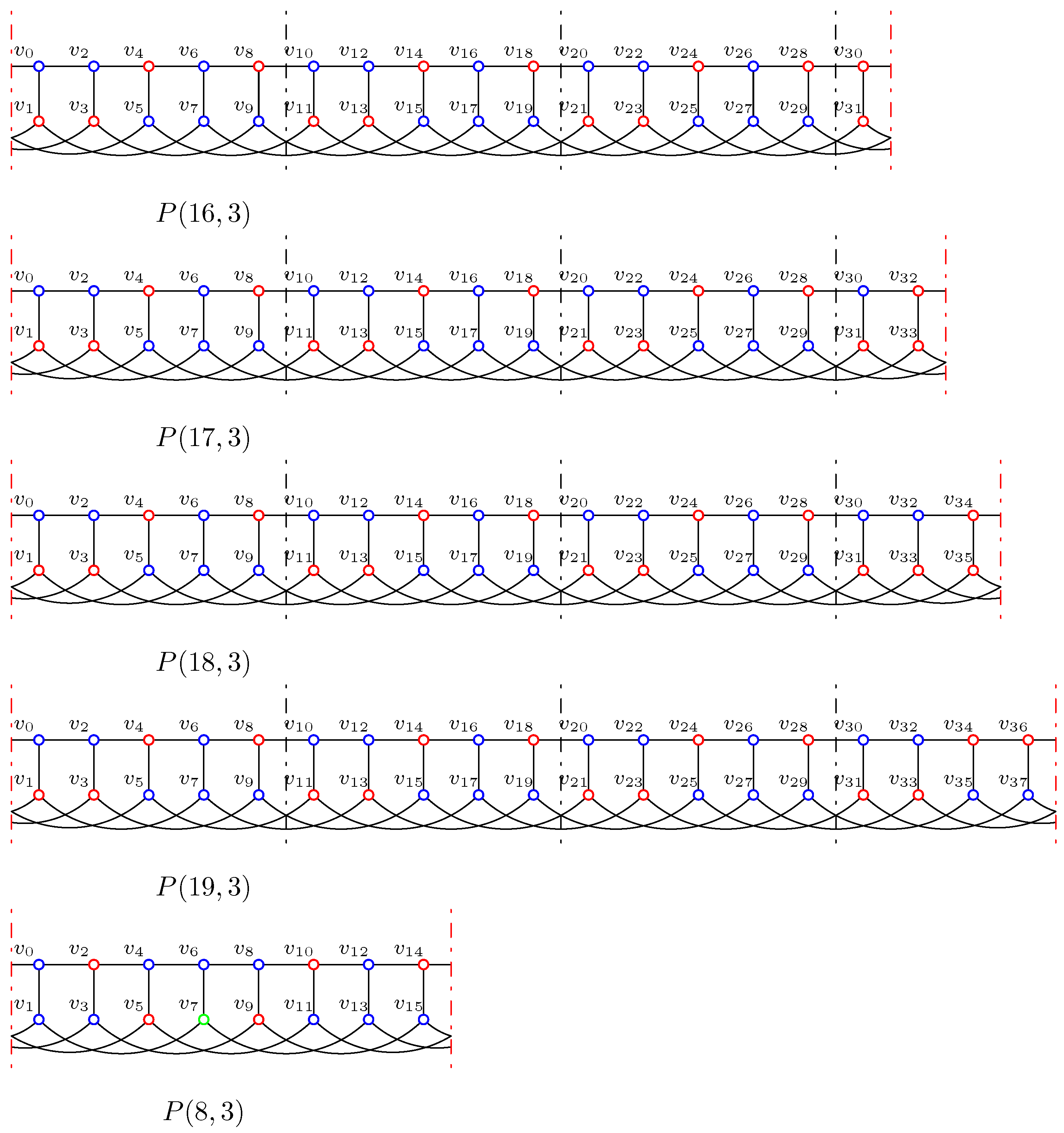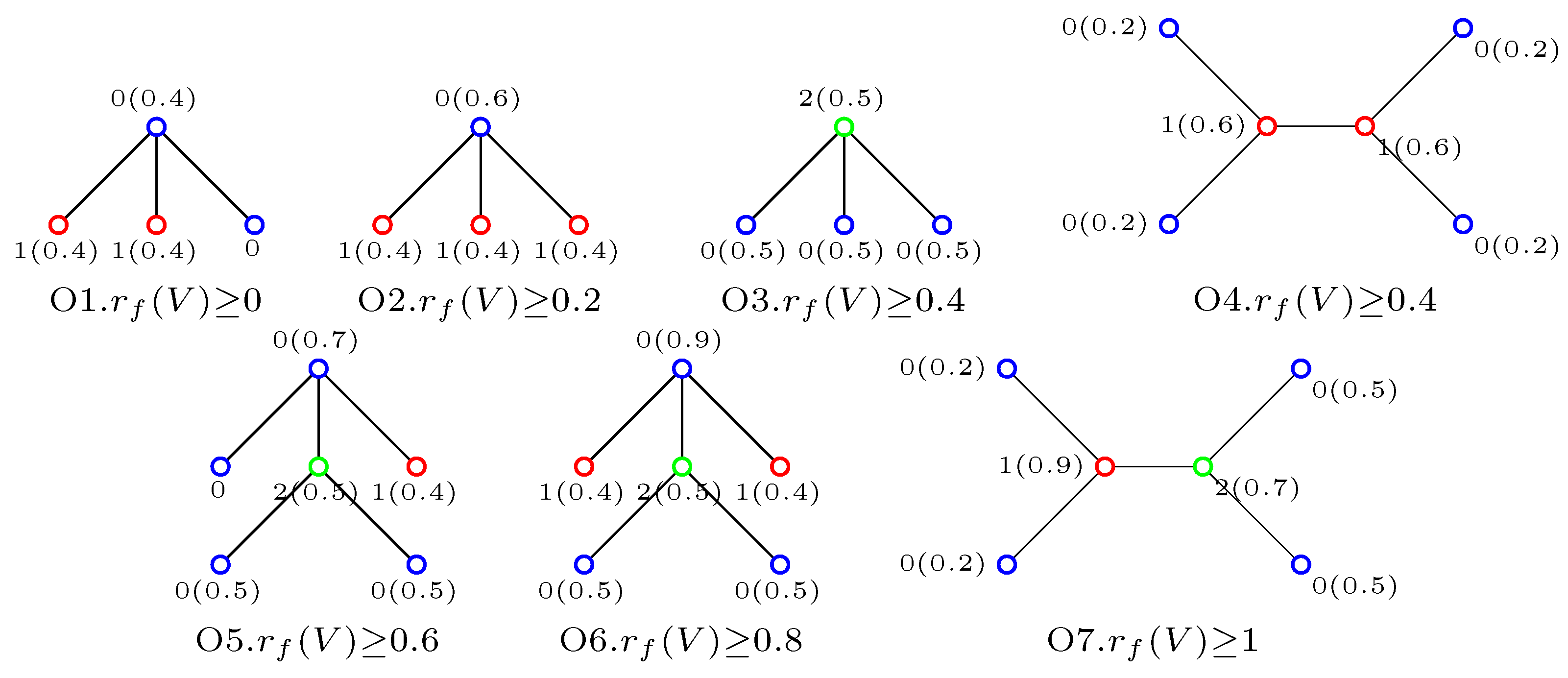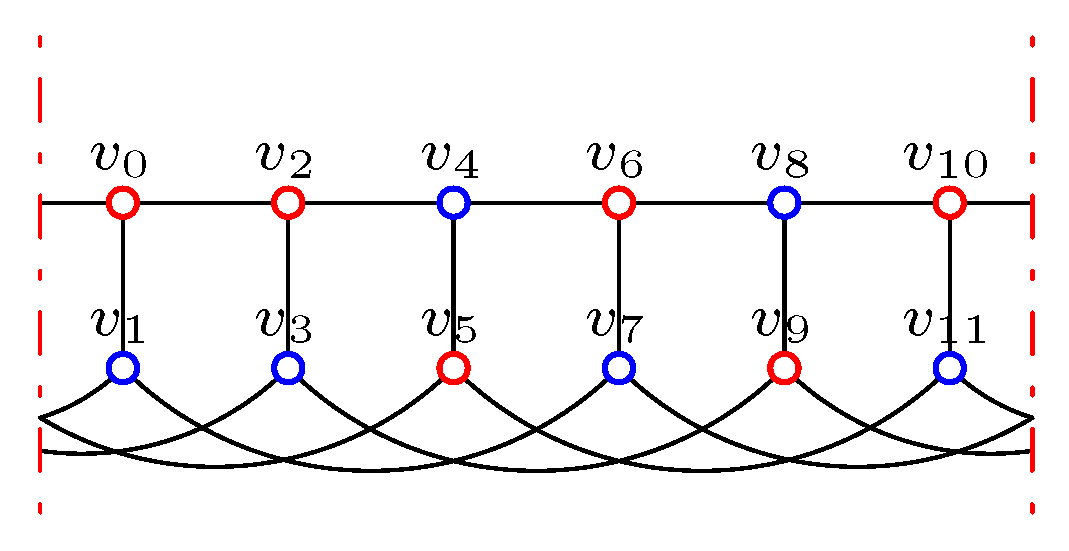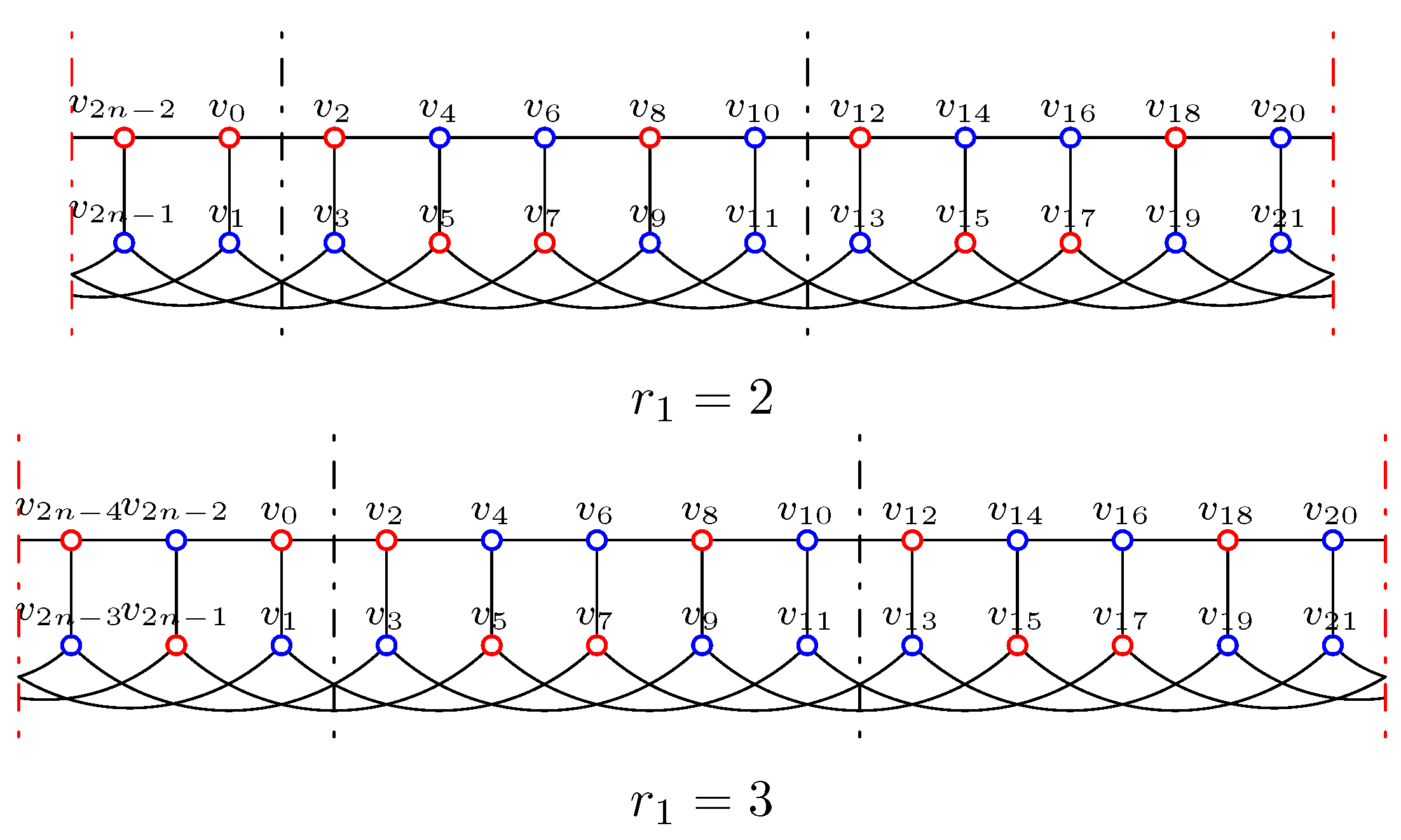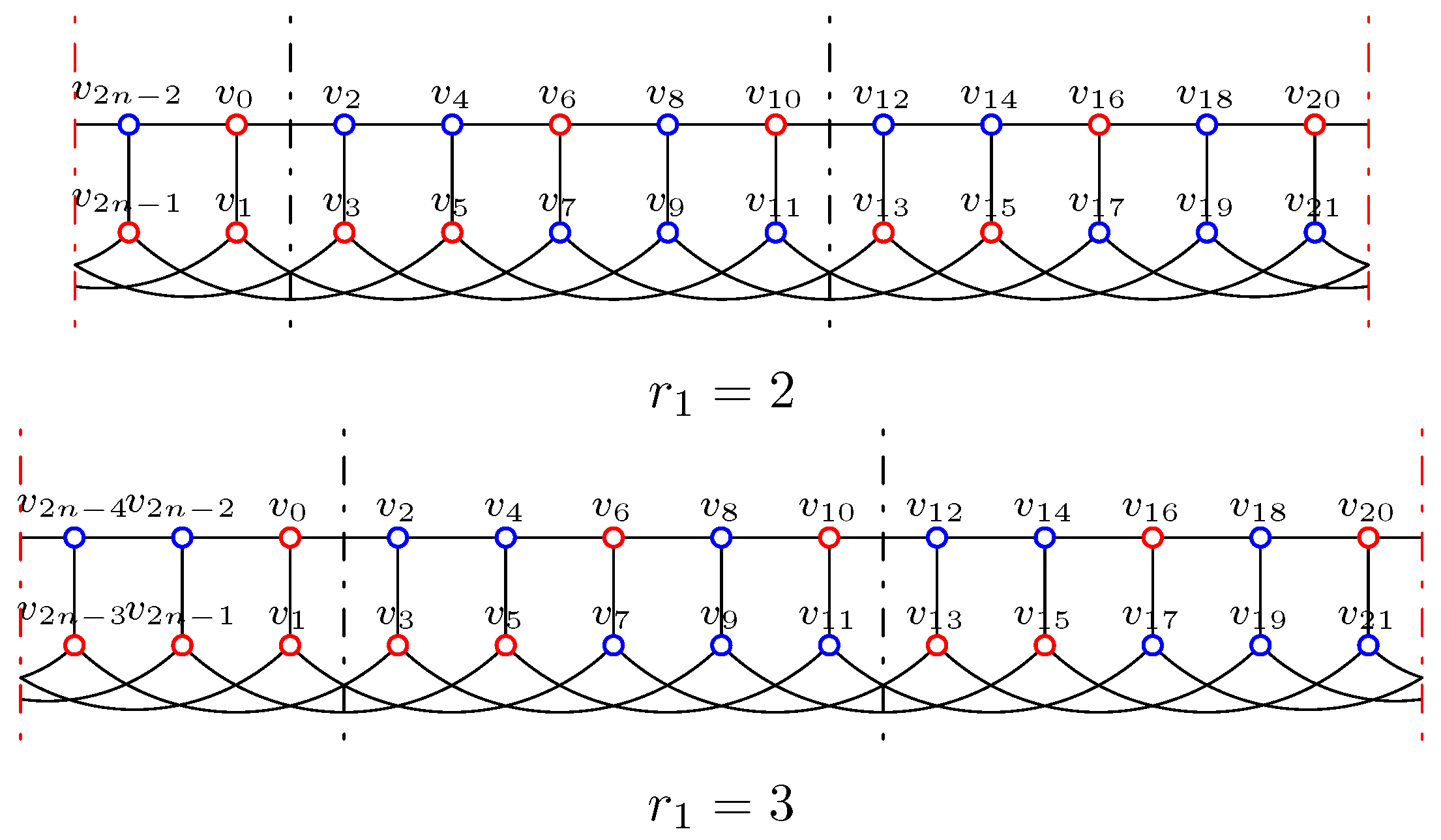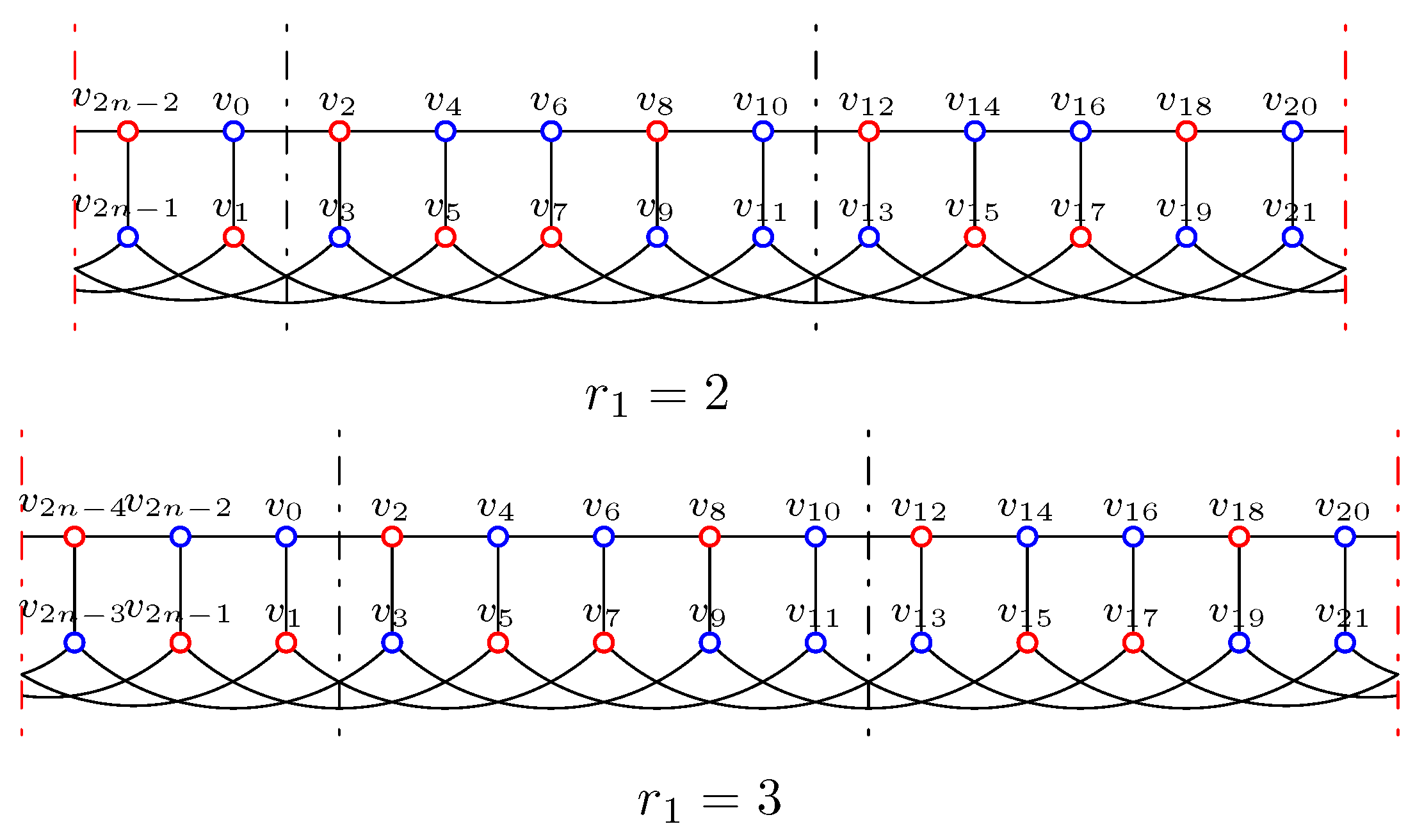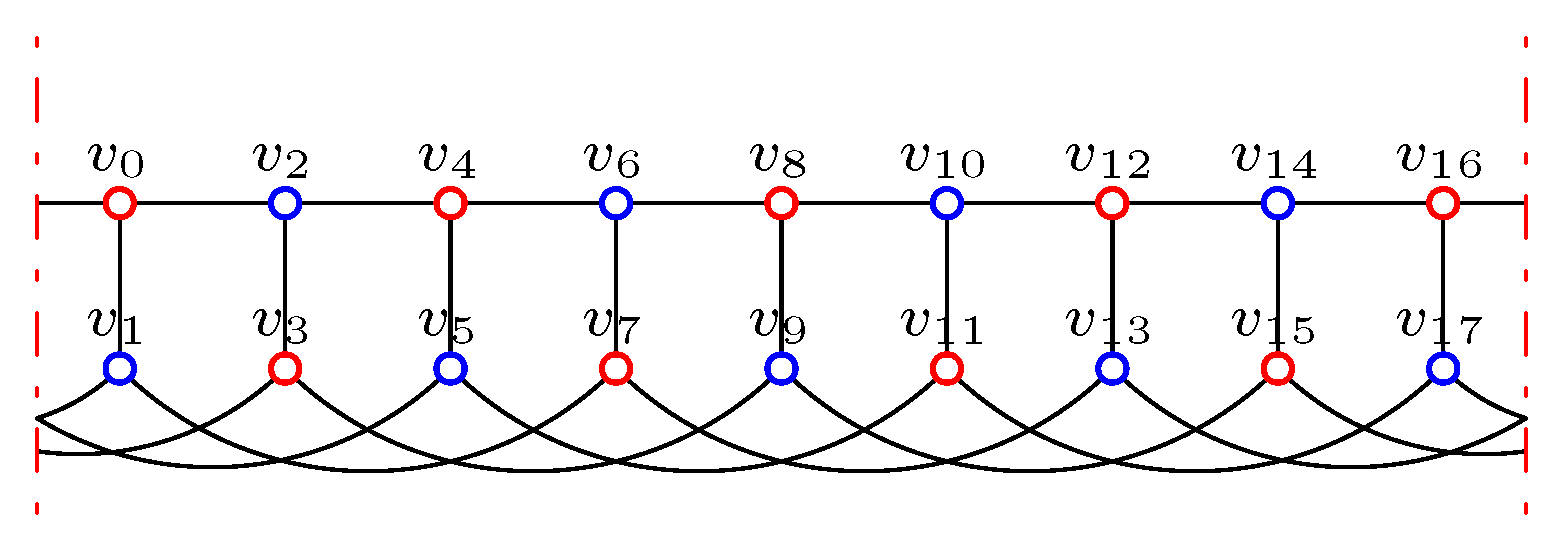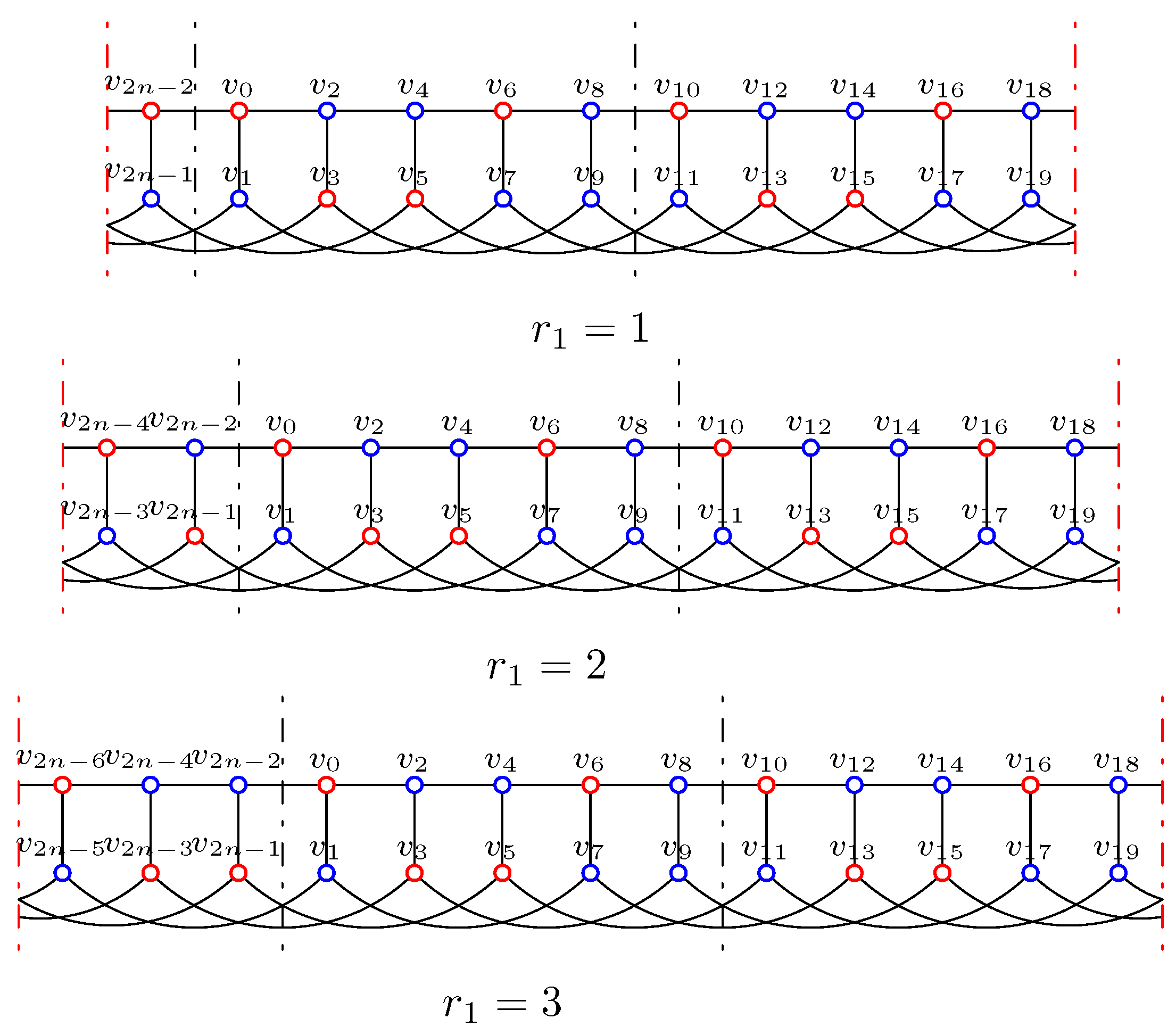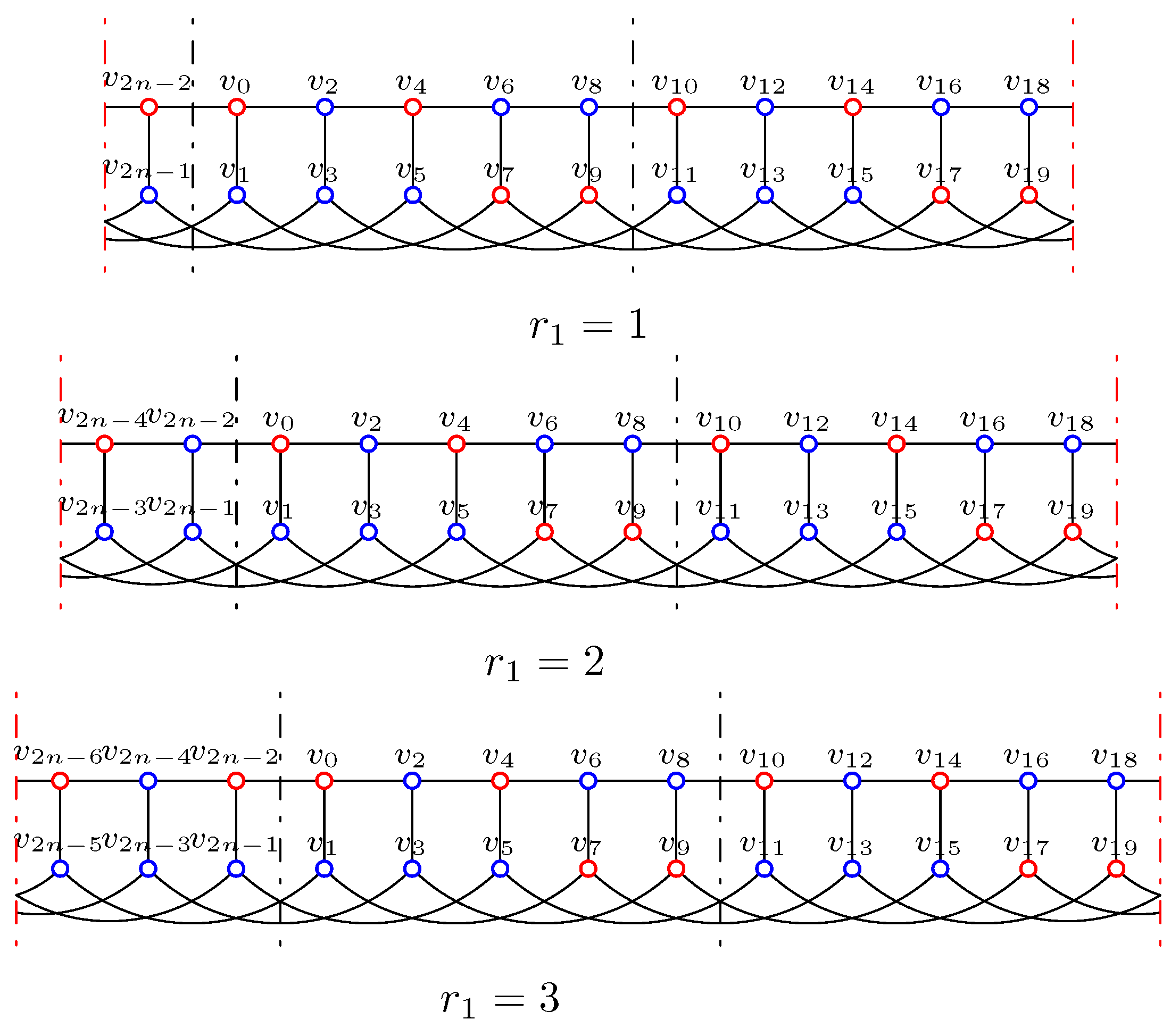1. Introduction
In a graph G with vertex set and edge set , for any , the open neighborhood of a vertex is a set , denoted by and the closed neighborhood of a vertex is . The degree of a vertex is , denoted by . The minimum (maximum) degree of G is denoted by (△). is a cycle with n vertexes. is the Cartesian product of two graphs G and H. A set , if for every vertex , v is adjacent to a vertex in D, then D is called a dominating set. The minimum cardinality of a domination set of G is called the domination number of G, denoted by . There are many different types of domination which have been researched extensively. In recent years, Roman domination as one of a variety of dominations has attracted scholars to study it extensively.
Roman domination is originated from the problem of how to develop defense strategies to defend the Roman cities [
1]. If the city has a legion or can be defended from neighboring cities, it is safe. The emperor decreed that a city must have two legions to defend it, so that it can still make it safe after sending one of its legions to a neighboring city. Considering the cost, the emperor wanted to station as few legions as possible. A function
is a Roman dominating function (RDF) [
2] if it satisfies the condition that every vertex
u with
is adjacent to at least one vertex
v with
. The value
is the weight of an RDF. The Roman domination number is the minimum weight of an RDF, denoted by
.
Since then, a lot of papers have been published on various aspects of Roman domination [
3,
4] and many variations [
5,
6,
7]. Italian domination is a new variation of Roman domination.
Italian domination is a generalization of Roman domination introduced by Mustapha Chellali et al. [
8], where it is also called Roman {2}-domination; Michael A. Henning et al. [
9] named the concept Italian domination. An Italian dominating function (IDF) is a function
such that for each vertex
v with
,
. The value of
is the weight of an IDF. The Italian domination number is the minimum weight of an IDF on
G, denoted as
.
Italian domination has attracted many researchers. Mustapha Chellali et al. [
8] present bounds relating the Italian domination number of a graph to the 2-rainbow domination number. They demonstrate that the Italian domination number is equal to the 2-rainbow domination number for trees and cactus graphs with no even cycles. Michael A. Henning et al. [
9] characterize the tree graphs
T with
, and characterize
T with
. Zofia Stȩpień et al. [
10] prove
. Zepeng Li et al. [
11] obtain the Italian domination numbers of
and
, where they call it weak {2}-domination number. Some scholars initiate other aspects of Italian domination, such as Abdelkader Rahmouni et al. [
12], who study independent Italian domination, Wenjie Fan et al. [
13], who study the outer-independent Italian domination number, and Lutz Volkmann [
14], who initiates the study of the Italian domatic number in digraphs.
Let be an IDF on a graph G, and be the ordered partition of V induced by f, where and , (). Then, there is a one to one correspondence between f and , so we denote . The weight of an IDF is the value . A function is a -function if it is an IDF and .
To decide the Italian domination number of a graph is NP-complete, even for bipartite graphs [
8]; so it is worthwhile to study the Italian domination numbers for some special classes of graphs. As an interesting family of graphs, various types of domination on generalized Petersen graphs have been studied extensively [
15,
16,
17,
18]. For two natural numbers
n and
k with
and
, the generalized Petersen graph
is a graph on
vertices,
and
, where subscripts are taken modulo
n.
Figure 1a shows the graph of
; for convenience and clarity, we always cut the graph
between
and
, and
Figure 1b shows the cut
.
While there are many studies on Italian domination, the results of Italian domination on have not been reported. In this paper, the Italian domination number of is studied. We determined the exact value of the Italian domination number on .
3. Lower Bounds on the Italian Domination Number of
Lemma 4. Let G be a graph , .
Proof. By using Theorem 11 in [
8],
. In
,
,
, so we obtain the lower bound. □
By Theorem 1 and Lemma 4, we can get Theorem 2.
Theorem 2. For and , .
Theorem 3. For and , .
In order to prove Theorem 3, we need some definitions, observations and lemmas. Let be an arbitrary IDF of , we define functions and as follows.
Definition 2. Define for , and for .
By Definition 1 and 2, we have the following observations.
Observation 1. For any vertex , .
Observation 2. - O1
If there exists a vertex v with and , then .
- O2
If there exists a vertex v with and , then .
- O3
If there exists a vertex v with , then .
- O4
If there exists a pair of vertices with and , then .
- O5
If there exists a vertex v with and , then .
- O6
If there exists a vertex v with , , and , then .
- O7
If there exists a pair of vertices with , and , then .
Figure 4 shows
O1–
O7 in Observation 2 (where red vertices stand for
, blue vertices stand for
and green vertices stand for
).
Lemma 5. Let ; if f is a , then .
Proof. is a
regular graph, i.e.,
for every vertex
. By Definition 1 and definition the of IDF, it has
□
Lemma 6. For and , let f is a , then Proof. By Definition 2 and Lemma 5, , so , .
Let
.
□
Based on
O3,
O4,
O6 and
O7, if one of the conditions in
Table 2 appears, then
(
).
In fact, is always true; so, besides these sufficient conditions, the following cases need to be considered:
- (1)
.
- (2)
.
- (3)
∃ with .
- (4)
Excluding these sufficient conditions and cases (1)–(3), then , , and , . In this case, by the definition of IDF, for , , .
In the sequel, we will prove in the above four cases by Lemmas 7–10.
Lemma 7. If there is a vertex v with , then .
Proof. Suppose or .
For , by O3, .
For , by contrast, suppose .
Case 1.. By excluding , for .
By excluding , . Then, or 0.
Case 1.1.. By O5, , .
By excluding , . By the definition of IDF, , .
By excluding , . By the definition of IDF, .
By excluding , .
Continuing in this way, it has
, and .
, and .
Since , , , then and , by –, , a contradiction.
Figure 5 shows the segment of
f, where red vertices stand for
, blue vertices stand for
and green vertices stand for
.
Case 1.2.. By excluding , or 0.
Case 1.2.1.. By O5, , .
By excluding , .
Next, or 0. If , then , and , , , , by O5, , a contradiction; so .
By the definition of IDF,
. Then
and
, by
and
,
, a contradiction.
Figure 6 (left) shows the segments of
f.
Case 1.2.2..
By the definition of IDF, . By excluding , .
By excluding , . By the definition of IDF, .
By excluding , . By the definition of IDF, .
Then,
and
, by
O2 and
O3,
, a contradiction.
Figure 6 (right) shows the segments of
f.
Case 2.. By excluding , for and .
By excluding , . Then, or 0.
Case 2.1.. By O5, , .
By excluding , . By the definition of IDF, .
Next, or 0. If , then , , , by O2 and O5, , a contradiction. So, .
By the definition of IDF, . By excluding , .
By the definition of IDF, .
Continuing in this way, it has
, and ,
, and .
Since
,
,
, then
and
, by
O7,
, a contradiction.
Figure 7 shows the segment of
f.
Case 2.2..
By the definition of IDF, . By excluding , .
By excluding , . By the definition of IDF, .
By excluding , . By the definition of IDF, .
Next, or 0.
Case 2.2.1.. Then, , by O2 and O3, , .
By excluding , . By the definition of IDF, .
Then
and
, by
O2 and
O3,
, a contradiction.
Figure 8 (above) shows the segment of
f.
Case 2.2.2..
By the definition of IDF, .
By excluding , .
By the definition of IDF, . By excluding , .
Continuing in this way, it has
,
.
For , and , by O5, , a contradiction.
For
,
,
, then
,
,
, by
O3–
O4,
, a contradiction.
Figure 8 (below) shows the segment of
f.
□
Lemma 8. If there exists a pair of vertices with and , then .
Proof. Without loss of generality, let or or
For , by O4, .
For
, by contrast, suppose
. Similar to Lemma 7, by excluding the sufficient conditions in
Table 2 and Lemma 7, and by the definition of IDF, we can get the values of each vertex step by step.
Case 1.. After that, , and or 0.
Case 1.1.. Then, or 0.
Case 1.1.1.. Afterwards,
,
. Then
and
, by
O2 and
O4,
, a contradiction.
Figure 9 shows the segment of
f.
Case 1.1.2.. Then, it has
, ,
, .
For , , , then , , and , by O4, , a contradiction.
For
,
,
, then
,
, and
, by
O4,
, a contradiction.
Figure 10 shows the segments of
f.
Case 1.2.. After that, we can get the values of
.
Figure 11 shows the segment of
f. Since
and
, by
O4,
.
Case 2.. Afterwards, , or 0.
Case 2.1.. After that, or 0.
Case 2.1.1.. Then, it has
, ,
, .
For , , by O2 and O4, , a contradiction.
For
,
and
, by
O4,
, a contradiction.
Figure 12 shows the segment of
f.
Case 2.1.2.. Then, it has
, ,
, .
For , , , then , by O2 and O4, , a contradiction.
For
,
, then
and
, by
O4,
, a contradiction.
Figure 13 shows the segments of
f.
Case 2.2.. Afterwards,
,
,
, then
, by
O4,
, a contradiction.
Figure 14 shows the segment of
f.
Case 3.. Then, it has
, ,
, .
For , , then , by O2 and O4, , a contradiction.
For
,
, then
and
, by
O4,
, a contradiction.
Figure 15 shows the segments of
f for
and
.
□
Lemma 9. If there exists a vertex v with and , then .
Proof. Without loss of generality, it is assumed that and .
Similar to Lemma 7, by excluding the sufficient conditions in
Table 2 and Lemma 7 and 8, and by the definition of IDF, we can get the values of each vertex step by step.
Figure 16 shows the values of
. Then,
,
,
and
, by
O2,
for
.
□
Lemma 10. If there exists , and , then .
Proof. Without loss of generality, let
. By contrast, suppose
. Similar to Lemma 7, by excluding the sufficient conditions in
Table 2 and Lemmas 7–9, and by the definition of IDF, we can get the values of each vertex step by step.
Next, , or 0.
Case1. . Then, it has
, ,
, .
For , , then and , by O4, , a contradiction.
For , , , then , and , by O2 and O4, , a contradiction.
For
,
, then
, and
,
, by
O4,
, a contradiction.
Figure 17 shows the segments of
f in this case.
Case2. . Then, it has
, ,
, .
For , , then and , by O4, , a contradiction.
For , , then , by the definition of IDF, this case can not exist.
For
,
, then
, by the definition of IDF, this case can not exist.
Figure 18 shows the segments of
f in this case.
□
By Lemmas 7–10 and the sufficient conditions in
Table 2, we can get that for
,
, i.e.,
. That is, Theorem 3 holds.
By Theorems 1 and 3, we can obtain
Theorem 4. For and , By Theorems 2 and 4, we have
Theorem 5. Let G be a graph ,
